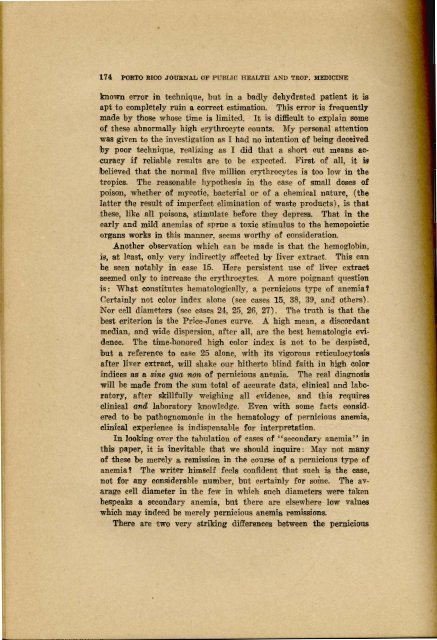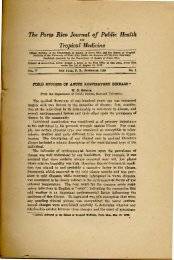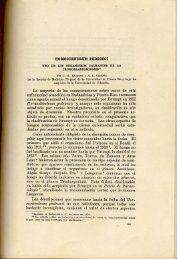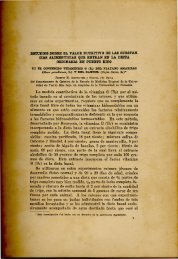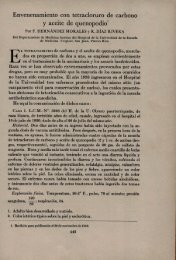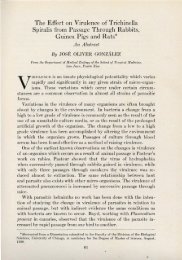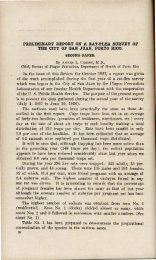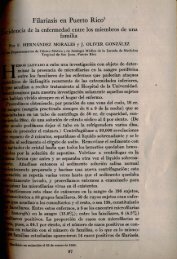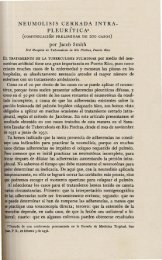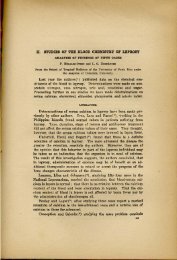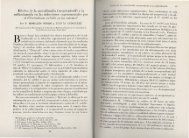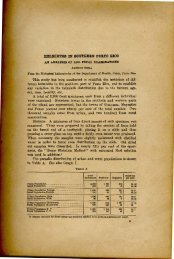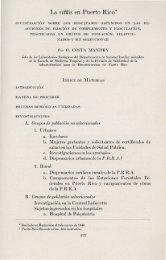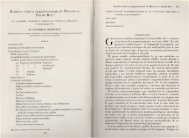Classification of Anemias.pdf
Classification of Anemias.pdf
Classification of Anemias.pdf
Create successful ePaper yourself
Turn your PDF publications into a flip-book with our unique Google optimized e-Paper software.
174 PORTO RICO JOURNAL OF P UBLIC H EAIJTH AND TROP. MEDICINE<br />
known error in technique, 'but in a badly dehydrated patient it is<br />
apt to completely ruin a correct estimation. This error is fre quently<br />
made by those whose tim e is limited. It is difficult to explain some<br />
<strong>of</strong> these abnormally high eryth r ocyte counts. My personal attention<br />
was given to the investigation as I had no intention <strong>of</strong> being deceived<br />
by poor technique, realizing as I did that a short cut means accuracy<br />
if reliable results arc to be expected. F irst <strong>of</strong> all, it is<br />
!believed that th e normal five million erythrocytes is too low in the<br />
tropics. The reasonabl e hypothesis in t he caSe <strong>of</strong> small doses <strong>of</strong><br />
poison, whether <strong>of</strong> mycotic, bacterial or <strong>of</strong> a chemical nature , (the<br />
latter the result <strong>of</strong> imperfect elimination <strong>of</strong> waste products) , is that<br />
these, like all poisons, stimulate before th ey depress. That in the<br />
early and mild anemias <strong>of</strong> sprue a toxic stimulus to the hemopoietic<br />
organs works in this manner , seems worthy <strong>of</strong> consideration.<br />
Another observation which can be made is that th e hemoglobin ,<br />
is, at least, only very indirectly affected by liver extract. This can<br />
be seen notably in case 15. H ere persistent use <strong>of</strong> liver extract<br />
seemed only to increase the erythrocytes, A more poignant question<br />
is: Wh at constitutes hematologically, a pernicious type '<strong>of</strong> anemi a '<br />
Certainly not color index alone (see cases 15, 38, 39, and others) .<br />
iNor cell diameters (see cases 24, 25, 26, 27) . The truth is that the<br />
best criterion is the Price-Jones curve. A high mean , a discordant<br />
medi an, and wide dispersion, after all, are the best hematologic evidenc<br />
e. The ti me-honored high color index is not to be despised,<br />
but a reference to case 25 alone, with its vigorous reticulocytosls<br />
after liver extract, will shake our hitherto blind faith in high color<br />
indices as a sine qua non <strong>of</strong>' pernicious anemia. The real diagnosis<br />
will be made from the sum total <strong>of</strong> accurate data, clinical and lab o<br />
r atory, after skillfully weighing all evidence , and this requires<br />
clinical and laboratory knowledge. Even with some facts considered<br />
t o be pathognomonic in the hematology <strong>of</strong> pernicious anemia:<br />
clinical experience is indispensable for interpretation.<br />
In looking over the ta bulatio n <strong>of</strong> cases <strong>of</strong> "secondary anemia" in<br />
this paper, it is inevitable that we should inquire : May not many<br />
<strong>of</strong> these be merely a. remission in the course <strong>of</strong> a pernicious typ e <strong>of</strong><br />
anemia The writer himself feels confident th at such is the ease,<br />
not for any considerable number, but certainly for some. The avarage<br />
cell diameter in the few in which such diam eters were taken<br />
bespeaks a secondary anemia, but there are elsewhere low values<br />
which may indeed be merely pernicious anemia. remissions.<br />
There are two very striking differences between the pernleious


